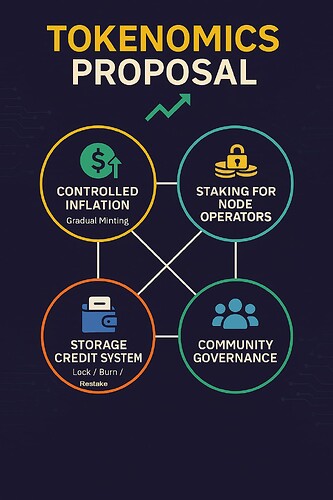Well, well… STORJ is more than just a utility token. It’s a store of value, based on supply and demand for storage space, as it has a closed/capped market of circulating tokens. These tokens are directly impacted by the companies increasing revenue via demand; while both burdening the company, and defining it’s success. Going forward, all revenue streams the company has should be added to the tokenomics. Especially the $30 Million plus they used to do acquisitions last year, and their supplemental distribution of tokens to the former owners of those acquisitions - it’s an asset. Out the gate, they should be at least generating a 20% margin annually for the GPU etc. stuff - or they made a bad investment. You can calculate the liquidation $s used for these acquisitions as it’s all in the token reports. I’d estimate the original .50 ICO was primarily liquidated at an average under <.34 just by browsing those quarterly reports over time (Jesus, they actually liquidated all the way down to 22-24 cents in one of the last liquidation quarters). Additionally the supplemental payment was probably 15 million tokens for the gpu/etc. acquisitions.
They can’t say it publicly, but it is an ‘investment’ vehicle, and they know it. So add the other gpu/object mount payment options to STORJ, in fact add all revenue streams. Early adopters as the AI business is, know there’s investment acceleration and their demand, business segment alone generates more margin than storage alone. Pack it all in the token… Complete the synergy and push the coin, advertise it. Be responsible, and commit to some phrasing that the additional available coins will not be opened until full profitability or target coin value, and some time line.
Any company could buy 100 million tokens, and lock in at a $24 million cost right now.
The value of time kicks in, and it becomes difficult to get tokens to pay for storage/gpu/etc., thus the price rises. It’s a commodity coin, not unlike gold or copper. Gains on the coin are booked annually on their Balance Sheet at fair market value, and can affect their Income Statement via capital gains/losses. It’s definitely an asset of the company - you can’t just ignore it.
That push should raise the value of STORJ, increase/impact their Balance Sheet and they can liquidate more coins for cash needs in the future. All their business segments can contribute to locking in an future higher value, as customers demand and invest in their future needs. Any token increase is a source of revenue for Storj. While they accept fiat for services this coin still can be more widely adopted and continue to contribute significan gains.
If the burgeoning profitability of the new segments over the last year contributed less than $6 million, or a current value of about 25 million tokens I’d be disappointed. Over the next year I’d be looking to announce a token buy back or $100k a month - 400,000 to 500,000 STORJ per month. Let the segment with the most demand boost the token value, as the margin of anything not storage is obviously higher.
Frustratingly I can’t see the books, to actually advise anything, other than don’t liquidate the remaining treasury under .50.
As for the Russian thing, as I’ve said before, any large western prospects will shy away due to their security/availability concerns for that fact alone. Fix that, cap it - do something, you have enough operating headway now in current storage availability. It’s probably been a costly political harpoon for too long, check you customer exit interviews & their concerns as to why they didn’t sign on, other than SOC certification.
Advise us as to the progress on the phantom public network certification, that will have a definite impact the asset base.
5 more cents,
Julio
